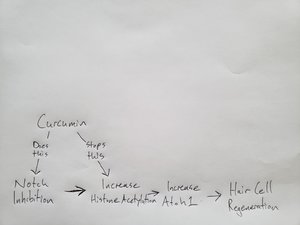that's what it seems like to me. I think we need to figure out how to induce atoh1 expression somehow.
im looking into if anything can in fact go through the eardrum.
Celastor Can induce this, as you know. Side effects are not too severe as in LY411575 and injecting thru the eardrum can cause -30dB all range.
.......................................................................................
I think ATOH1 is the most important.
"Notch intracellular domain (NICD) is cleaved by gamma secretase (GS) and activates Hes1. Hes1 blocks Muc2 activation via blockage of ATOH1 and the cell retains a progenitor state. In the cell where Notch is inactive, ATOH1 activates MUC2 and the cell adopts a goblet cell fate."
Good article:
Notch Signaling and Atoh1 Expression During Hair Cell Regeneration in the Mouse Utricle
https://www.ncbi.nlm.nih.gov/pmc/articles/PMC2902641/
"Using immunohistochemistry, we observed that Jagged1 was located in the supporting cells of the normal utricle and remained in those cells after a lesion. Atoh1 was not detected in the normal tissue but appeared after the trauma. qRTPCR data showed a post trauma decrease for
Hes5 and an increase in
Atoh1 after the lesion, with no significant change in
Notch1, Jagged1 and Hes1.
Our results present a new ototoxic regimen for a complete elimination of utricular hair cells. We document changes in expression level of
Atoh1 and
Hes genes and no marked change in
Jagged1. We find Atoh1 and myosin VIIa-positive cells early after the lesion suggesting that the process of spontaneous regeneration may start several days after the insult. Our data also suggest that Atoh1 up-regulation leading to hair cell regeneration may be induced by more than one signaling pathway."
We have shown that the response of cells in the utricle to an ototoxic trauma involve changes of Notch signaling molecules and Atoh1 expression. Using qRTPCR we detected down-regulation of
Hes5, up-regulation of
Atoh1 and no changes in levels of
Notch1, Jagged1 and
Hes1. Jagged1 is expressed in the supporting cells of normal utricle and remains in supporting cells after the lesion. Atoh1 immuno-fluorescence, undetectable in the normal mouse utricle, appears after trauma in nuclei with or without myosin VIIa labeling. Our results suggest that the spontaneous regeneration may arise earlier than previously thought and Atoh1 up-regulation may be initiated by more than one signaling pathway.
Inhibition of Notch signaling gives rise to ectopic hair cells in the developing and damaged organ of Corti (
Hori et al., 2007;
Yamamoto et al., 2006). In non-mammalian inner ears, inhibition of Notch signaling causes excessive regeneration of hair cells following a lesion, and over-expression of activated Notch in supporting cells inhibits hair cell regeneration (
Daudet et al., 2009;
Ma et al., 2008). These data raise the possibility that a therapy that would repress Notch signaling may also be applied in the traumatized mammalian vestibular epithelium, in order to enhance hair cell regeneration. Notch inhibition could be accomplished, for instance, by using a γ-secretase inhibitor, or repressing the expression of critical Notch ligands or receptors using specific antagonists.
Virus mediated over-expression of Atoh1 in the damaged mammalian vestibular epithelium is a promising method for enhancing regeneration of hair cells (
Staecker et al., 2007). However, non-invasive pathways using small molecules with no side effects may be necessary for clinical applicability. In addition, elimination of
Hes5, the repressor of
Atoh1, using siRNA at a suitable time point after a lesion may potentially increase expression of Atoh1, which could lead to a larger numbers of new hair cells.
Pathways other than Notch signaling may additionally be involved in regulating proliferation and other aspects of tissue response to trauma in the mammalian vestibular epithelium.
,,,,,,,,,,,,,,,,,,,,,,,,,,,,,,,,,,,,,,,,,,,,,,,,,,,,,,,,,,,,,,,,,,,,,,,,,,,,,,,,,,,,,,,,,,,,,
This is way beyond me. I am technically educated.

 Member
Member